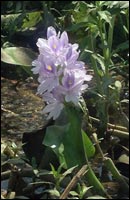Invasive Species
Introduction | Species Info | Teacher Materials | Resources
Species Information: Water Hyacinths
 Many people in Louisiana are surprised to learn that water hyacinths are not native plants because they are found throughout the state in bayous, lakes and even drainage ditches. This floating, flowering plant from South America was introduced into Florida in the 1890s, and into Louisiana around 1903 at the Cotton Exposition in New Orleans. Today, it is considered an invasive species throughout the South by some, although also valued as one of the top-selling plants for the water garden industry.
Many people in Louisiana are surprised to learn that water hyacinths are not native plants because they are found throughout the state in bayous, lakes and even drainage ditches. This floating, flowering plant from South America was introduced into Florida in the 1890s, and into Louisiana around 1903 at the Cotton Exposition in New Orleans. Today, it is considered an invasive species throughout the South by some, although also valued as one of the top-selling plants for the water garden industry.
This plant forms a dense floating carpet on ponds, lakes and bayous that blocks sunlight. Lack of sunlight often kills submerged plants and results in low oxygen levels in the water. In addition, as leaves drop off and decay, more sediment falls to the waterway’s bottom, increasing sedimentation rates in the waterway.
The plant has dark green, waxy, rounded and cupped leaves attached to a bulb-shaped petiole. Seasonally, a spike of lavender flowers at the end of a stem is produced. Each floating plant has dense, fibrous, branching roots that may extend for 2-3 feet beneath each plant, and a rhizome to start a new plant. Plants can vary in size from a few inches to more than 3 feet tall. In Louisiana, they are rarely more than 12 inches.
Download a PDF with more species information about Water Hyacinths
